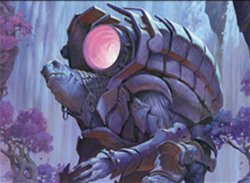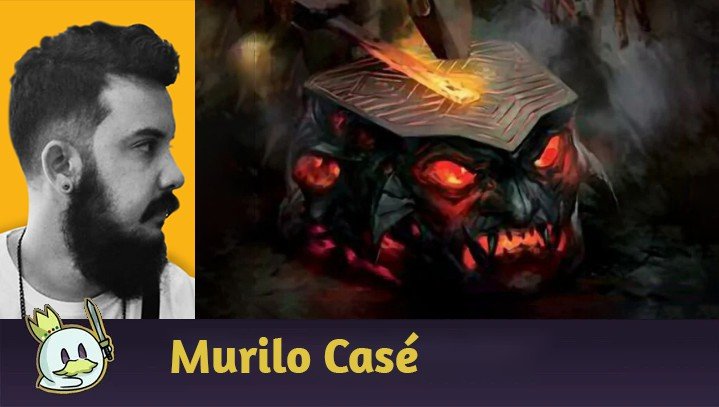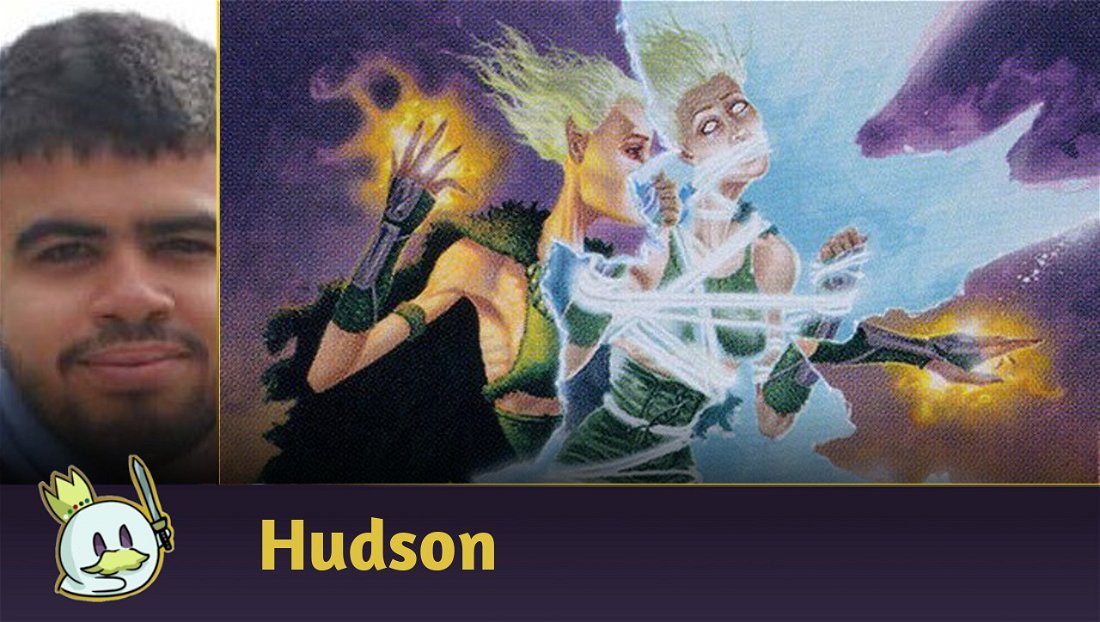Presentation
My name is Elton Fior, but you can call me Eltinho, and this is my first article for Card Realm of several I intend to write about Legacy.
For those who still don't know me, I've been a Magic player since 1996, I was Brazilian vice-champion twice (2004 and 2006) and after a temporary retirement in 2012, I've been a recurring figure on the Legacy circuit in Brasília since 2018, always carrying the Red Prison banner!
Knowing the Deck
But enough with the presentations, let's get down to business: Deck Techs! For this first article I'm going to discuss 8-Cast, an archetype that although recent in Legacy, has its roots way back in the distant past, in the original Affinity.

When people think of Affinity, people automatically associate Arcbound Ravager and extremely offensive decks, but what few people remember is that before Darksteel forever encoded the deck as relentless aggression, it was a control deck using Thoughtcast as fuel and Broodstar as finisher. Swap the giant flying cockroach for a turtle armed with a cannon (Blastoise, is that you?) and we have a winning deck!

The 8-Cast (also referred to as Artifact Blue and sometimes using just 7 “Casts”) is a relatively recent archetype to the Legacy setting, solidified with the inclusions of Kappa Cannoneer, Urza's Saga and Thought Monitor. The name comes from the nickname given to cards with Affinity that draw two cards, Thoughtcast and Thought Monitor, and to fuel these and other synergies, it uses a considerable amount of artifacts, preferably at the lowest possible cost. It's also one of the few blue decks in the format that can afford to forgo Brainstorm and Ponder!
When this deck came out, it took the format off guard and its success was resounding, but now things have been adapting, and it's now one of several viable archetypes in Legacy, capable of extremely explosive plays combined with elements of Prison and Control.
Here's a list for reference before we discuss how the deck works, what the key cards are, and what's replaceable:
Posture
The first thing we can notice in the list is the large amount of artifacts, since most of the deck's synergies are based on reaching critical mass: you need to reduce the mana costs of the Casts, you need to improvise the Turtles (Kappa Cannoneer ), you must generate thopters with Sai, you have to fatten those Saga tokens.
Being able to use this amount of cheap artifacts to advance a strong play before the opponent can have the answer (Turtles on turns 2 or 3, for example) is usually the most common and most effective path to victory with this deck. However, being so focused on these interactions, which is a feature common to decks like Affinity and graveyard decks (All Spells, Dredge, Hogaak, Reanimator) and which makes them very efficient in pre-Sideboard games, makes it more fragile against opponents that come with a lot of answers in games 2 and 3.

Another important aspect is that, while not as focused as other Prison decks, 8-Cast manages to make good use of Chalice of the Void, having enough tools to play the card with a counter on turn 1 – Ancient Tomb, Lotus Petal, Mox Opal + 2 0-mana Artifacts (Seat of the Synod works on this account too), an absolutely devastating move against the vast majority of decks right now.
As I mentioned above, not using the ubiquitous blue duo of Brainstorm and Ponder makes sense when you have the plan to punish one mana cards through the Chalice's false symmetry. The presence of these mana accelerator cards also increases the threat rating of Urza's Saga, as the ability to activate the token generation on turn 2 of a Saga played on 1, coupled with the large number of artifacts in the deck, puts great pressure on the opponent.

The deck also has some versatile cards to solve some game situations like Otawara, Soaring City (remember that the ability has a reduced cost for Emry, Lurker of the Loch and Sai, Master Thopterist), Aether Spellbomb and Shadowspear — and these two can conveniently be tutored by Urza's Saga.
Mulligan
As for mulligans, as this is a deck that can take on many roles, you need to assess what your starting hand offers and which path you will have to take.
On the draw, for example, it's important to be more reactive and have access to Force of Will, so you don't fall victim to explosive decks like Storm, Oops or Red Prison. On the play, you can afford to keep hands that will result in a Blastoise, I mean, Kappa Cannoneer on turn 2 or a Chalice to 1 on turn 1.
Hands that fall halfway between the deck's various play styles or that offer a lot of acceleration but no cards to make use of or even a way to replenish are candidates for Mulligan.
Deck Building
Regarding the Maindeck suggested above, it is very common for players to cut one of the Casts (7-Cast) or even reduce the total of the other creatures to make room for some other cards.
Among the most common cards to appear in the main deck in these spaces are Retrofitter Foundry (one of the preferred targets for Chapter III of the Saga), Karn, the Great Creator, Lightning Greaves, Mox Amber, Soul-Guide Lantern, Unlicensed Hearse and Welding Jar.
The proposed Sideboard aims at a broad Metagame, but different environments may demand other cards. Common cards to find here, in addition to those listed above, are Hydroblast/Blue Elemental Blast, Flusterstorm, Grafdigger's Cage, Mystical Dispute, Surgical Extraction, Tormod's Crypt, Torpor Orb as well as targets for lists that might use Karn, the Great Creator, such as Ensnaring Bridge, Liquimetal Coating and Mycosynth Lattice.
Sideboard Guide
About the sideboard, as I mentioned earlier, it's a deck that can suffer a lot against the hate dedicated to it, some might be brutal like Null Rod, Serenity, Seeds of Innocence, Collector Ouphe and Meltdown, so there will be situations where you will have to side against your opponent's side and often not put all your eggs in one basket, so you don't lose everything at once.
And as for Force of Negation, you need to be careful when removing too many blue cards when bringing them to the main deck and having difficulty having cards to pay the alternative cost.
Below is a guide against the main decks of the format:
Izzet Delver
Your main threats are generally immune to Lightning Bolt — Turtle, Sai, and Saga tokens, and you can usually play around Daze.
The main cards that this deck usually comes up against you are Pyroblast/Red Elemental Blast, Abrade, and the most complicated, Meltdown. Many other decks tend to trade Force of Will for more proactive cards against Delver, but you can't afford that luxury - Meltdown is pretty much game over unless you've managed to resolve a Cannoneer.
IN:

OUT:

Death and Taxes
They don't have many answers against the Turtle and luckily Mother of Runes doesn't grant protection from artifacts, but coming from the sideboard some decks have started using Kataki, War's Wage and even Serenity in some cases.
Chalice, in addition to not being very effective against them, can be used against you through Flickerwisp, changing it from 1 to 0.
IN:

(Remember that you can make Sunburst for 2 with Mox Opal and Lotus Petal)
OUT:

Burn
They are extremely vulnerable to Chalice and the main card against artifacts they use is Smash to Smithereens, although Meltdown is starting to appear in lists.
Here your objective is either to fit a Chalice and protect it or to quickly put a big threat into play and win the race — Shadowspear is great for cheating this contest. Brazen Borrower is interesting for dealing with potentially problematic cards like Sulfuric Vortex or Maddening Hex.
IN:

OUT:

Jeskai/Grixis Control
Although they are quite different decks, our game plan is similar against both. Grixis has access to Meltdown and Hidetsugu Consumes All while Jeskai can add Null Rod or Serenity against you, and neither is good news.
IN:

OUT:

BG Depths
This is the matchup in which Aether Spellbomb shines!
Shadowspear can also put you out of the singe-hit range by Marit Lage. Post-side, it is common for them to come with Seeds of Innocence and/or Collector Ouphe. Dismember is for dealing with both Ouphe and Elvish Reclaimer.
IN:

OUT:

Red Prison
Chalice for 0 and Trinisphere are extremely problematic cards, and they tend to come with Fiery Confluence after game 1, having counters to hold these cards is crucial. Except for Bridge, they have no means of responding to Turtle.
IN:

OUT:

Oops, All Spells
They have Force of Vigor and some discards to try to force the combo over our Chalices and counters, it's not easy for them, but an oversight is enough for them to go all-in.
IN:

OUT:

Mirror Match
Here it is important to be as explosive as possible, so very slow hands must be a mulligan. Usually, the first Turtle to resolve wins the game.
IN:

OUT:
(on draw)

(on play)

Conclusion
I hope you enjoyed this article, and you can be sure there will be more to come!
Thanks for reading!















— Comments 0
, Reactions 1
Be the first to comment